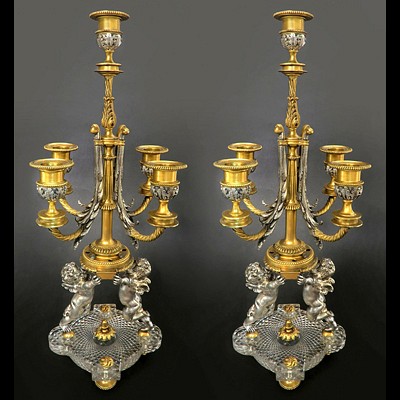A Wondering Man, George Grattan (19th C.) Watercolor
About Seller
1260 S Central Ave
Glendale, CA 91204-2596
United States
Antique Kingdom Inc. is established in Orange County, California and serves a myriad of online art lovers, with utmost respect, unfailing transparency and limitless passion. A true enchantment for your artistic senses in the purest form, with an endless, immeasurable bounty of authentic historic bro...Read more
Two ways to bid:
- Leave a max absentee bid and the platform will bid on your behalf up to your maximum bid during the live auction.
- Bid live during the auction and your bids will be submitted real-time to the auctioneer.
Bid Increments
| Price | Bid Increment |
|---|---|
| $0 | $50 |
| $300 | $100 |
| $1,000 | $250 |
| $5,000 | $500 |
| $10,000 | $1,000 |
| $50,000 | $2,500 |
| $100,000 | $5,000 |
| $200,000 | $7,500 |
| $500,000 | $10,000 |
| $1,000,000 | $25,000 |
About Auction
Sep 7, 2021
California #1 Antique Auction Antique Kingdom Inc. antiquekingdom1@gmail.com
- Lot Description
George GRATTAN (1787-1819) Watercolor Painting Of A Wondering Man. Frame: 28" x 24", Painting: 19" x 15". About Artist: A native of Dublin, he was born in 1787 and from his childhood showed a predilection for art. Entering the Dublin Society's Schools he gained medals in 1797 and succeeding years, and in 1800 was given a gratuity of ten guineas "as an encouragement to his genius," and to enable him to purchase colors, canvas, etc. In the following year a sum of twenty pounds per annum was allowed him out of the funds of the Society, "as an encouragement to his studies and a means of assisting him in his education." While still a student in the schools he painted miniatures and sent seven works, portraits and landscapes, to the exhibition in the Parliament House in 1801. For one of his landscapes he was awarded a premium by the Dublin Society. Commenting on his works a contemporary paper says: "If this boy be properly attended to, and if he himself does but modestly and sedulously cultivate his fine and vigorous genius, he will at a future day prove an honor to his country and the Arts." In 1802 he was given a prize for a clay model of a figure, and in 1803 he obtained first prize for a landscape from nature. General Vallancey helped and befriended him, and brought him to the notice of the Lord Lieutenant, the Earl of Hardwicke, for whom he did several crayon portraits and views. On leaving the schools he established himself, in 1804, in Chatham Street, and exhibited that year at the Artists' Exhibition in Dame Street. His early works were chiefly in crayons and water-colors, mostly portraits and landscapes; but he afterwards devoted himself more particularly to historical subjects and rural and domestic scenes in oil. Amongst his works which attracted notice were his "David and Abigail," and "Jane Shore dying." In 1807 he painted a large picture of a "Beggar-woman and Child," which the Dublin Society purchased from him for one hundred guineas, declaring that the work "discovers the highest talents, and deserves the warmest appreciation." The Society likewise agreed to allow the artist to take the picture to London for exhibition, and granted him a further sum of one hundred guineas for his expenses. Grattan accordingly took the picture to London, but being too late for the Academy Exhibition he exhibited it privately. He returned to Dublin after an absence of six months and sent the picture to the exhibition held at the Dublin Society's House in Hawkins Street in 1809. On the death of F. R. West in January, 1809, Grattan was a candidate for the vacant mastership in the School; but although the committee reported that the drawings sent in by him were decidedly superior to those of R. L. West, the latter artist was appointed. Grattan addressed a protest to the Society, and the drawings he had submitted, viz.: "The Race of Hippomanes and Atalanta" and "Antinous," were purchased for one hundred guineas. In 1812 the artist again went to London, and exhibited in the Royal Academy "The Guard-Room," illustrating lines in Canto VI of "The Lady of the Lake"; and "The Gathering," illustrating Canto III, and "Noontide." He also showed at the British Institution his pictures of "The meeting of David and Abigail," and "The Race of Hippomanes and Atalanta," the latter a large work 9 feet by 5 feet 6 inches. He did not remain long in London, and was back in Dublin in 1813. In Dublin he was an exhibitor at the various artists' exhibitions in 1801, 1804, and from 1809 to 1813, after which latter year he no longer exhibited; nor do we hear anything more of him as an artist. He fell into ill-health, and removing to Cullenswood for change died there on the 18th June, 1819. He was buried on the 21st in the old churchyard at Glasnevin, where the following inscription may still be read upon his tombstone: Here lieth George Grattan; He was pre-eminently skill'd as a painter, and was justly considered one of the brightest flowers of Irish Genius; He devoted his short life to the duties of a son and the affections of a brother. His piety was of that retiring kind which hides itself from human scrutiny, and while he saw and admired the beauty of this world, he yet worked and hoped through Christ our Lord to be received into another and better. He died June 18, 1819.
- Shipping Info
-
Bidder is responsible for all shipping costs. We recommend "Ship 1" Tel: 714-975-1342, ship1info@gmail.com or "Box n Ship" at 626-793-1607, Boxnship-pasadena@sbcglobal.net, We are not responsible for any damage in shipping, we suggest you purchase insurance. Items will be released to shippers after 3 business days of payments processing.
-
- Payment & Auction Policies
-
Available payment options
For Payment, We do accept Credit Cards by click on "MAKE A PAYMENT" in your invoice page or Cashier's checks, personal checks and Bank Wire Transfers. - If you wish to send a Personal Check or Cashier's Check: Please make Payable to: Antique Kingdom. - Send to: 1260 S Central Ave, Glendale, CA 91204. -- If you wish to use a Bank Wire Transfer: ( recommended for faster shipping ). Our Bank information is as follows. Wire to: Antique Kingdom. Bank Name: CalPrivate Bank Acct #: 525537. ABA# Routing #: 122244029. For International: Swift # CLPVUS66 XXX. Bank address: 9606 S. Santa Monica Blvd, 3rd floor, Beverly Hills, CA 90210. We will notify you as soon as payment has cleared our bank. You may then directly arrange your shipping. We will assist and supply Contact Info for possible Shippers. Note: Antique Kingdom will NOT ACCEPT credit card payments on such items as Watches & Jewelry!
-
-
- Buyer's Premium



 EUR
EUR CAD
CAD AUD
AUD GBP
GBP MXN
MXN HKD
HKD CNY
CNY MYR
MYR SEK
SEK SGD
SGD CHF
CHF THB
THB













